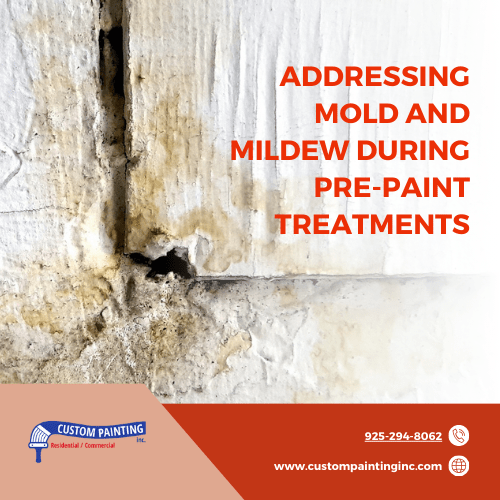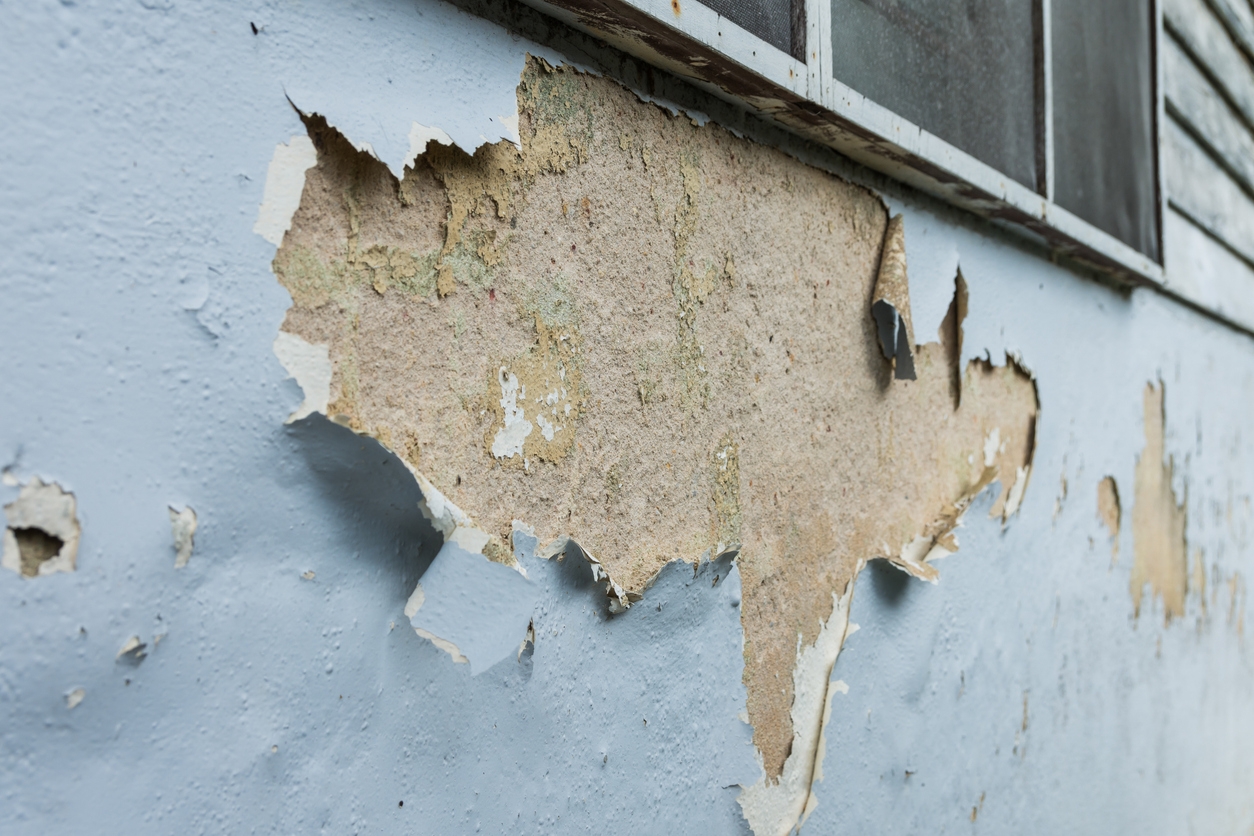When you decide to paint the exterior of your house, it’s really important to clean up any mold or mildew first. These tiny living things can grow on your walls if they’re not taken care of, and they can cause problems not just for your house but also for your health. This article will help prepare your home for a fresh coat of paint by ensuring mold and mildew are gone. We’ll also look at why sometimes it’s a good idea to get help from professional painters.
Understanding Mold and Mildew
Before we get your house in Pleasant Hill, CA, ready for a paint job, let’s talk about mold and mildew. Even though they might seem similar, there are some differences between them. Both are types of fungi that can grow on various surfaces, especially in moist places that don’t get a lot of sunlight. While mold is usually fuzzy and can be black, green, red, or blue, mildew is powdery and often appears white or gray.
Why They Grow Outside Your House
The outside of your house can be a perfect place for mold and mildew to grow. This is because these fungi love moisture. After it rains, mold and mildew might grow if the water stays on your walls or cracks. They’re also more likely to appear if your house doesn’t get a lot of direct sunlight or if there’s a lot of humidity in the air.
Why It’s a Big Deal
You might wonder why you should bother about a bit of mold or mildew on your house’s exterior. Besides not looking nice, these fungi can damage your home over time. They can eat away at paint, causing it to peel and crack. Even worse, if mold makes its way inside, it can cause health problems for you and your family, like allergies or respiratory issues.
Understanding these basics about mold and mildew is the first step in making sure your home looks great with its new paint and stays healthy and strong for a long time.
Identification and Assessment
Knowing what mold and mildew look like and where they’re most likely to appear is key to keeping your home in good shape, especially before painting. Here’s how to spot them and figure out what to do next.
Spotting Mold and Mildew
Mold and mildew can pop up in places that stay wet like rainwater splashes onto your walls or shady spots that don’t dry out easily. Mold looks fuzzy or slimy and can be in various colors, while mildew is usually powdery and gray or white. If you see discolored patches or spots on your home’s exterior, especially in these kinds of areas, you might be looking at mold or mildew.
Checking the Severity
Not all mold and mildew problems are the same. Sometimes, if it’s just a small area affected, you can clean it up yourself. But if it’s spread over a large area or keeps coming back, that signifies a bigger problem. It’s also important to check for any damage to your home, like rotting wood or paint peeling, as this can tell you how serious the issue is.
Deciding on the Next Steps
- Small Areas: If the mold or mildew is only in a small area, you might need some cleaning supplies and a bit of elbow grease to get rid of it.
- Widespread Issues: Getting professional advice is a good idea for larger areas or if there’s damage to your home. They can help determine why mold and mildew are growing and how to stop them for good.
- Health and Safety: Always consider safety when dealing with mold and mildew. If you have allergies or breathing problems, or if the affected area is large, it might be safer to get help from someone who knows how to handle it without causing health risks.
Knowing how to identify mold and mildew and assessing how bad the problem is are crucial steps in getting your home ready for a fresh coat of paint. Making sure these issues are dealt with properly means your paint job will look better and last longer.
Pre-Paint Treatment for Mold and Mildew
Getting rid of mold and mildew is a must before you start painting the outside of your house. Here’s how to tackle it step by step so your paint sticks better and lasts longer.
Cleaning the Surface
- Safety First: Wear gloves, goggles, and a mask to protect yourself from mold spores and cleaning solutions.
- Choose the Right Cleaner: A mixture of water and mild detergent might work for mild cases. For tougher mold or mildew, you might need a solution for killing mold, which you can find at most hardware stores.
- Scrubbing the Area: Use a brush with stiff bristles to gently scrub the moldy or mildewed areas. Be thorough but careful not to damage the surface of your home.
- Rinsing Off: After scrubbing, rinse the area well with clean water to remove any leftover cleaner and loosened mold.
- Let It Dry: Make sure the surface is completely dry before painting. Depending on the weather and how much water you use, this might take a day or more.
Preparing the Surface
Once the mold and mildew are gone and the surface is dry, you should do more prep before it’s ready to paint.
- Check for Damage: Look for any damage mold or mildew might have caused, like rotting wood or peeling paint. You’ll need to fix these issues before painting.
- Prime the Surface: Applying a primer can help prevent mold and mildew from coming back, so look for a primer that’s made to fight against mold and mildew.
Safety Precautions
Dealing with mold and mildew involves using chemicals and exposing yourself to potentially harmful spores. Here are some key safety tips:
- Always wear protective gear, like gloves, goggles, and masks.
- Keep the area well-ventilated to avoid breathing in fumes from cleaning solutions.
- Follow the instructions on any cleaning products carefully to ensure you’re using them safely and effectively.
Treating mold and mildew before painting helps ensure your paint job looks great and protects your home and health. You can tackle this problem and prepare your house for a beautiful new look with the right approach.
Best Tips to Prepare Your Home for Exterior Painting
Preparing your home for exterior paint isn’t just about dealing with mold and mildew. You should take several other steps to ensure the paint looks great and sticks around for a long time. Here are some of the best tips for preparing your home:
- Wash the Walls: Give your house a good wash before anything else. You can use a pressure washer or a hose with a cleaning solution to remove dirt, grime, and peeling paint. This step is crucial for making sure the new paint adheres properly.
- Remove Stains: Look for any stains from rust, oil, or grease and clean them off. There are specific cleaners for different stains, so use the right one.
- Fix Cracks and Holes: Inspect your home for cracks, holes, or other wall damage. Use the appropriate filler to repair these imperfections. Once the filler is dry, sand it down to make sure the surface is smooth and even.
- Replace Rotten Wood: If you find any rotten or severely damaged wood, it’s best to replace it before painting. Painting over damaged wood will only temporarily hide the problem, not fix it.
- Sand Rough Spots: After repairs, sand any rough spots to ensure smooth surfaces. This helps the new paint stick well and look smooth.
- Apply Primer: A good quality primer can make a huge difference in how the paint looks and how long it lasts. It helps cover up previous colors and provides a smooth base for the new paint. Make sure to choose a primer suitable for your area’s exterior surface and weather conditions.
- Paint in the Right Weather: Weather plays a big role in how well paint dries and adheres to your home. Avoid painting on rainy or very windy days. The best conditions for painting are mild temperatures and low humidity.
- Plan Your Project: Consider the time to prepare and paint your home. Make sure you have enough time to do everything without rushing. Rushing can lead to mistakes or poor-quality work.
- Protect Areas Not Being Painted: Use painter’s tape to cover windows, doors, and trim that you don’t want to get paint on. Also, cover plants, bushes, and any outdoor furniture with drop cloths to protect them from drips and spills.
Following these tips will set you up for a successful exterior paint job. The preparation may seem like a lot of work, but it’s worth it for a beautiful and long-lasting finish.
The Benefits of Hiring Professionals
When it comes to painting the exterior of your home, bringing in a professional team has several advantages. Here’s why considering professional painters might be your best bet:
- Quality Work: Professional painters bring expertise and experience that ensures high-quality work. They know how to prepare your home for painting, choose the right products, and apply the paint for a flawless finish.
- Problem Solving: Pros are also skilled at identifying and solving potential problems, such as mold, mildew, or damage that could affect the paint job. They know how to handle these issues effectively before they start painting.
- Better Tools and Materials: Professionals can access high-quality tools and materials that might not be available to the average homeowner. This includes specialized ladders, scaffolds, paints, and primers, ensuring a better finish and longer-lasting results.
- Speed: A professional team can do the job faster than a DIY effort. They have the manpower and expertise to work efficiently, minimizing your home’s disruption time.
- Convenience: Hiring professionals takes the burden off your shoulders. You don’t have to spend your weekends or vacation time doing prep work and painting; instead, you can focus on your routine or enjoy your free time.
- Long-Lasting Results: Because professionals know how to prepare surfaces and apply paint properly, the results are beautiful and more durable. This means you won’t have to repaint as often, saving money in the long run.
- Warranty: Many professional painting services offer a warranty on their work. This gives you peace of mind, knowing that if anything goes wrong or the paint doesn’t hold up as promised, they’ll return and fix it at no extra cost.
- Reduced Risk: Painting a house, especially a multi-story one, can be risky. Professionals are trained to work safely at heights, handle hazardous materials, and operate heavy equipment. By hiring pros, you’re also avoiding the potential for personal injury.
- Cost-Effective: While hiring professionals might seem more expensive upfront, the overall value is often worth the investment. Considering the quality, durability, efficiency, and peace of mind they provide, professional painting services can save you money and hassle in the long term.
While painting your home’s exterior could be a DIY project, the benefits of hiring professionals are significant. From their expertise and access to top-notch equipment to the convenience and safety they offer, professional painters ensure your painting project is done right, on time, and with lasting results.
Conclusion
Tackling mold and mildew before an exterior paint job and preparing your home correctly are key steps to ensuring your paint lasts, and your house looks great. Whether you decide to do it yourself or go with the pros, remember the importance of each step in the process.
If you’re leaning towards professional help for a hassle-free, high-quality job, consider contacting Custom Painting, Inc. Give us a call at 925-686-0903 or fill out our online form to get started on making your home look its best. We’re here to help with expert advice and top-notch service every step of the way.




